Related Research Articles
Phlyctaina is a monotypic litter moth genus of the family Erebidae. Its only species, Phlyctaina irrigualis, is found in North America. Both the genus and species were first described by Heinrich Benno Möschler in 1890.
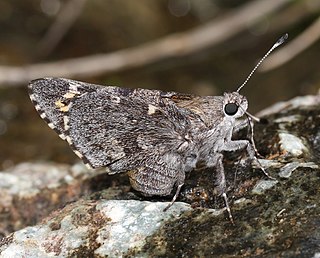
Agathymus aryxna, the Arizona giant skipper, is a butterfly in the family Hesperiidae described by Harrison Gray Dyar Jr. in 1905. Its range includes Central and North America.

Metalectra richardsi, or Richards' fungus moth, is a species of moth in the family Erebidae. The species was described by Auburn Edmond Brower in 1941. It is found in North America.
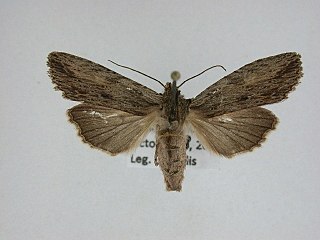
Lithophane signosa, the signate pinion or sycamore pinion moth, is a species of moth in the family Noctuidae. The species was described by Francis Walker in 1857. It is found in North America.
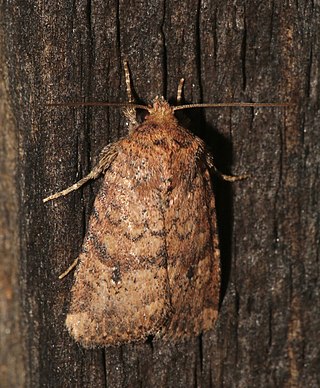
Homorthodes furfurata, the northern scurfy Quaker moth or scurfy Quaker moth, is a species of moth in the family Noctuidae . It was described by Augustus Radcliffe Grote in 1874 and is found in forest habitats in North America. Its range extends across the continent, to south-eastern Canada, Massachusetts, New York, and Mississippi. In the west it ranges south to California, Arizona, New Mexico and Texas.
Meganola varia is a species of moth in the family Nolidae and superfamily Noctuoidea. The species was first described by William Barnes and Arthur Ward Lindsey in 1921. It is found naturally in North America, where it has been recorded throughout Arizona, New Mexico, and western Texas. While some moths of its species have reportedly been photographed in California, Meganola varia is not found on the California Moth Checklist.

Macrochilo hypocritalis, the twin-dotted macrochilo, is a species of moth in the family Erebidae. The species was first described by Douglas C. Ferguson in 1982. It is found in North America, where it has been recorded from the eastern United States. The habitat consists of open, herb-dominated wetlands.
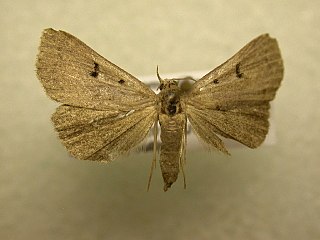
Bleptina inferior, the inferior owlet moth, is a species of moth in the family Erebidae. It was described by Augustus Radcliffe Grote in 1872 and is found in North America, where it has been recorded from Iowa to Massachusetts, south to Texas and Florida.
Annaphila arvalis is a species of moth in the family Noctuidae. It was described by Henry Edwards in 1875 and is found in North America, where it has been recorded from foothill canyons and riparian habitats in south-eastern British Columbia, eastern Washington, north-central Oregon, south to southern California.
Lacinipolia incurva is a species of moth in the family Noctuidae. It was described by John B. Smith in 1888 and is found in North America, where it has been recorded from California, Arizona, New Mexico, Texas, Utah and Colorado.
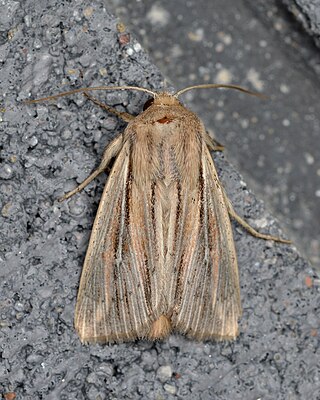
Leucania commoides, the comma wainscot or two-lined wainscot moth, is a species of cutworm or dart moth in the family Noctuidae. It was described by Achille Guenée in 1852 and is found in North America.

Meropleon ambifusca, or Newman's brocade, is a species of cutworm or dart moth in the family Noctuidae. It was described by Newman in 1948 and is found in North America.

Papaipema speciosissima, the osmunda borer or regal fern borer, is a species of cutworm or dart moth in the family Noctuidae. It was described by Augustus Radcliffe Grote and Coleman Townsend Robinson in 1868 and is found in North America.
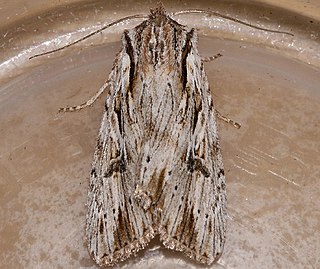
Xestia infimatis is a species of cutworm or dart moth in the family Noctuidae. It was described by Augustus Radcliffe Grote in 1880 and is found in North America.
Xestia laxa is a species of cutworm or dart moth in the family Noctuidae. It was described by J. Donald Lafontaine and Kauri Mikkola in 1998 and is found in North America.

Baileya levitans, the pale baileya, is a species of nolid moth in the family Nolidae. It was described by Smith in 1906 and is found in North America.
Chaetaglaea fergusoni, or Ferguson's sallow moth, is a moth in the family Noctuidae. It was described by Vernon Antoine Brou Jr. in 1997 and is found in North America.
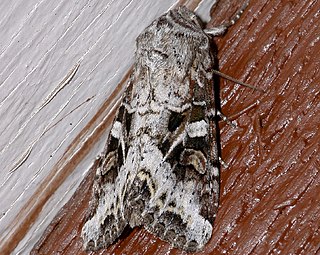
Trichordestra liquida is a species of cutworm or dart moth in the family Noctuidae. It is found in North America.
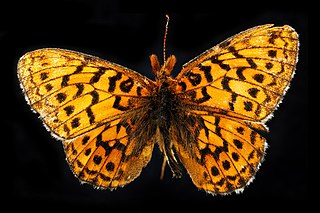
Boloria kriemhild, the relict fritillary, is a species of fritillary butterfly in the family Nymphalidae. It is found in North America.

A MONA number, or Hodges number after Ronald W. Hodges, is part of a numbering system for North American moths found north of Mexico in the Continental United States and Canada, as well as the island of Greenland. Introduced in 1983 by Hodges through the publication of Check List of the Lepidoptera of America North of Mexico, the system began an ongoing numeration process in order to compile a list of the over 12,000 moths of North America north of Mexico. The system numbers moths within the same family close together for identification purposes. For example, the species Epimartyria auricrinella begins the numbering system at 0001 while Epimartyria pardella is numbered 0002.
References
- ↑ Lafontaine JD, Schmidt BC (2010). "Annotated check list of the Noctuoidea (Insecta, Lepidoptera) of North America north of Mexico" (PDF). ZooKeys. Pensoft (40): 1–239. doi: 10.3897/zookeys.40.414 .